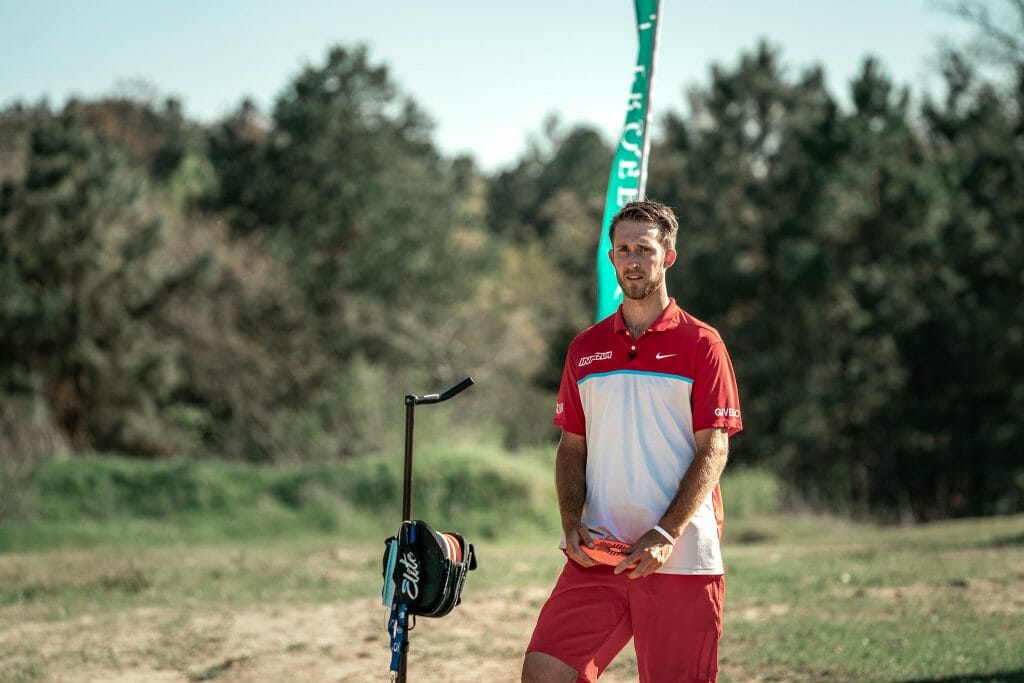Originally published at: https://discgolf.ultiworld.com/2021/04/01/the-frontier-of-putting-ricky-wysockis-performance-at-texas-states/
 Ricky Wysocki at the 2021 Texas State Championship. Photo: DGPT
Ricky Wysocki at the 2021 Texas State Championship. Photo: DGPT
Life is full of trade-offs. You cannot buy a car that is both the fastest and the most fuel efficient.1 Despite what the disc manufacturers tell you, there is no disc that will both maximize your distance potential and be dependable, consistent. However, on the course, the best pros maximize productivity by pushing trade-offs to the limits, and Ricky Wysocki’s putting performance at the Texas State Disc Golf Championship is a great example of just that.
Over the weekend, Wysocki took a fairly large number of meaningful putts — 38 from Circle 1X and C2 combined — and he made a lot of them: an astonishing 87% to be exact (including 100% from C1x). This combination of high efficiency and usage is in stark contrast to the trade-off that you see between these two sides of putting. Generally, if you attempt a lot of long, challenging putts, you shouldn’t be able to make a high percentage of them.
This trade-off between usage and efficiency has been examined in a lot of other sports using the concept of the Pareto optimality, because it is a way of determining maximum productivity. In the context of putting, if you cannot increase efficiency (putting percentage) without sacrificing usage (number of attempts), then you are maximizing your putting output and at a point called the Pareto frontier.
Was Wysocki’s performance at Texas States on the putting Pareto frontier? Well, to determine that, we first have to determine what the frontier is. To do this, I graphed the relationship between weighted average putting percentage (efficiency) and number of putting attempts (usage) for players that took at least 15 total putts (combined C1X and C2) and made at least 90% of the C1X putts and 45% of the C2 putts.2
What I found was a distinct frontier of points (in red) where either efficiency or usage do not increase without the other decreasing. The shape of the front (red line) makes a lot of sense. Those that made an absurdly high percentage of their putts didn’t attempt many, and those that attempted a lot of putts made relatively fewer.
As for Wysocki’s Texas States performance, you can see he nestles right behind Alex Russell’s 2019 performance in Portland. So, technically, no, he is not part of the Pareto frontier, but he is darn close. One made C1X putt short, to be exact. I think in spirit his performance fits the concept of the Pareto frontier. He putted at the bleeding edge line of what we know is possible.
Other metrics provide equally impressive support for how amazing Wysocki’s putting was in Texas. Only Alex Russell’s performance already mentioned and Austin Hannum’s 2019 Nick Hyde putting match or exceed Wysocki’s C1X and C2 percentages, though it is important to know that Hannum only attempted 17 total putts (C1X or C2).
Wysocki’s 87% weighted putting percentage ranks fifth in the UDisc era, and his strokes gained putting of 11.18 ranks 14th. He was probably hurt a bit here on the usage side, since he attempted only 38 qualifying putts. The number one strokes gained putting performance was by Michael Johansen at the 2017 GMC, where he attempted 51 putts, resulting in an unreal strokes gained putting of 15.57.3
In sum, Wysocki’s putting at Texas states was not unprecedented. It was not something we have never seen before. But it was still incredible. It is up there with the best putting performances of all time, and right at the edge of what is possible at this point in disc golf.
Unless you can afford a Porsche Taycan Turbo S. ↩
59 total players from all historical UDisc events met or exceeded these limits. ↩
It is important to note that the GMC had one more round than Texas states, which definitely helps Johansen’s usage. However, I think for this analysis it is important to not use attempts per round because part of what makes Johansen’s performance so impressive was that he had to keep up those high putting percentages for an entire round more than Wysocki, and he should be credited for it. ↩

